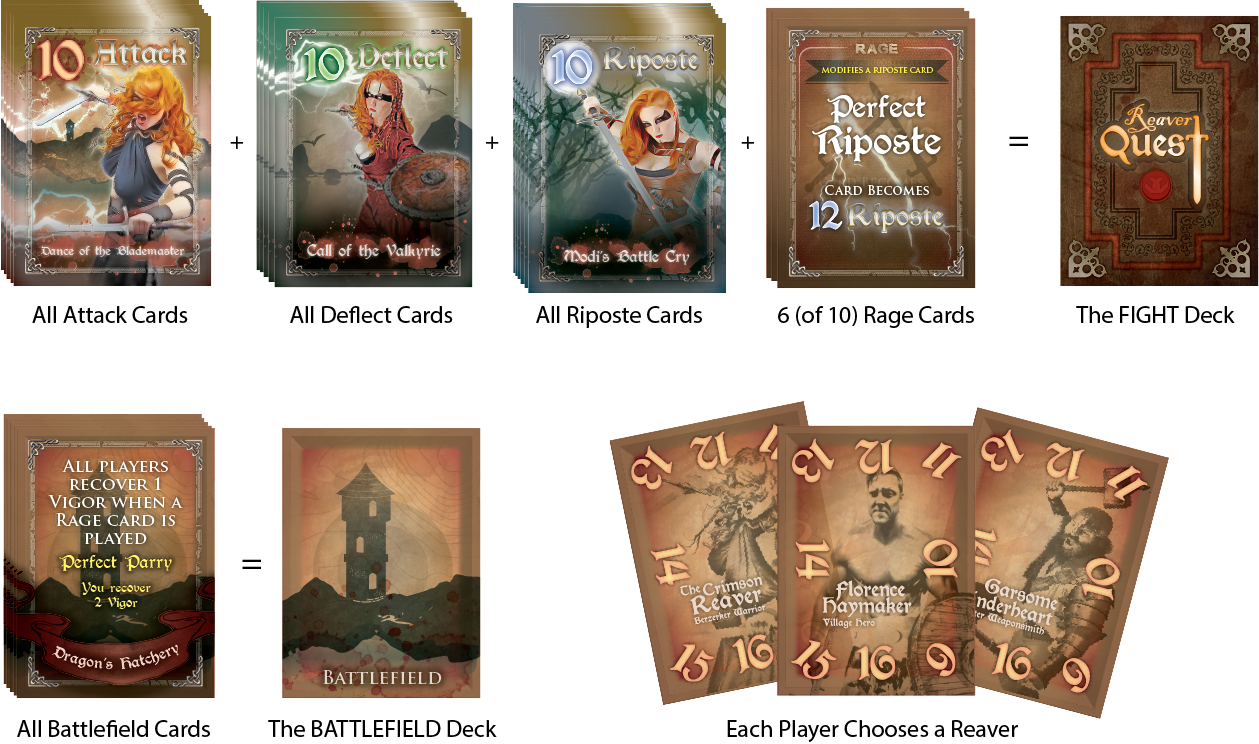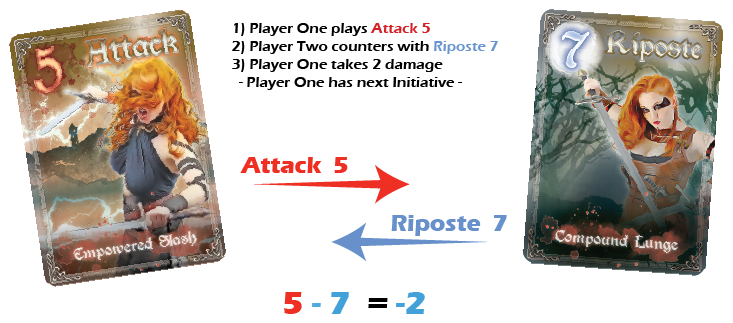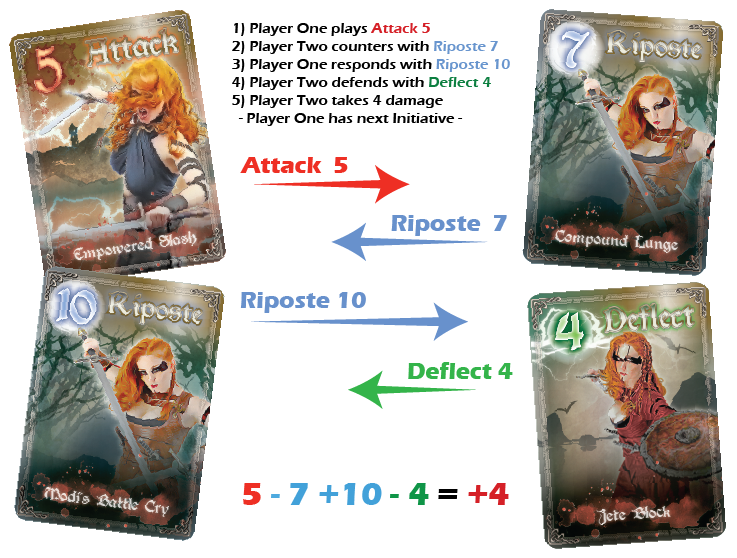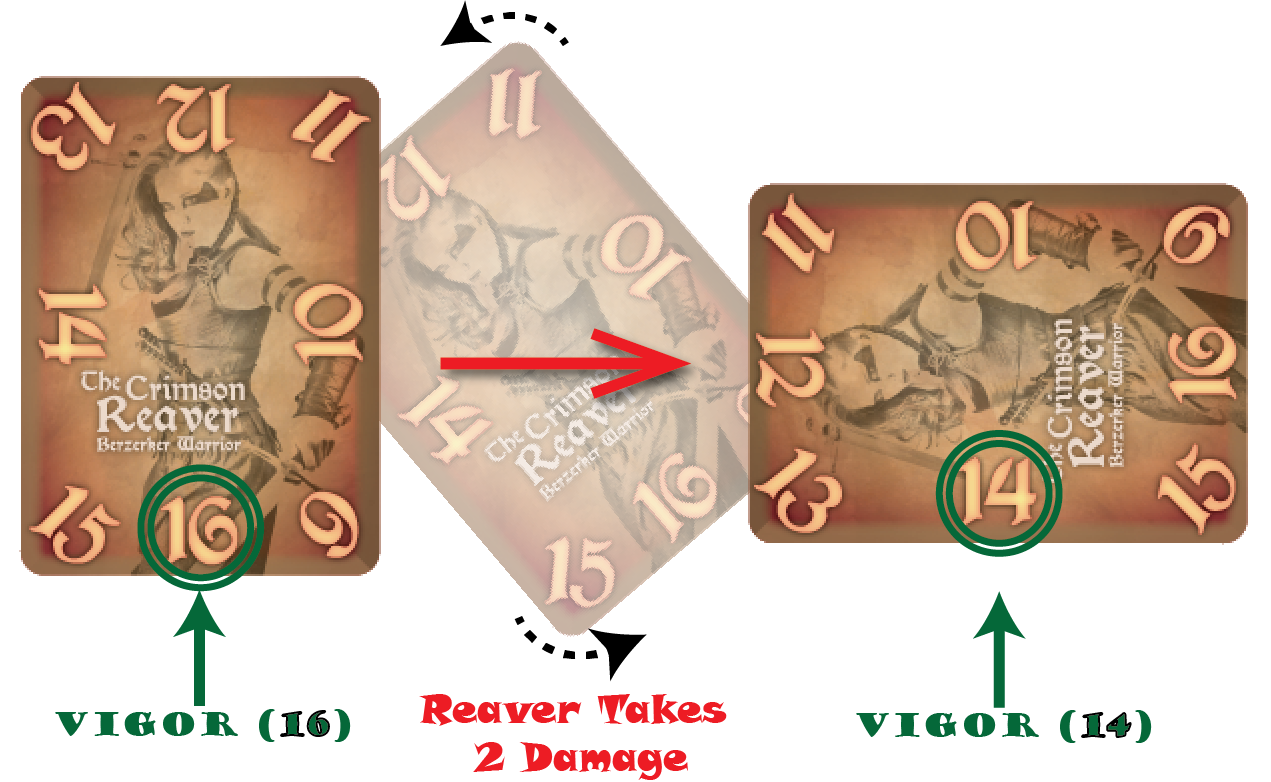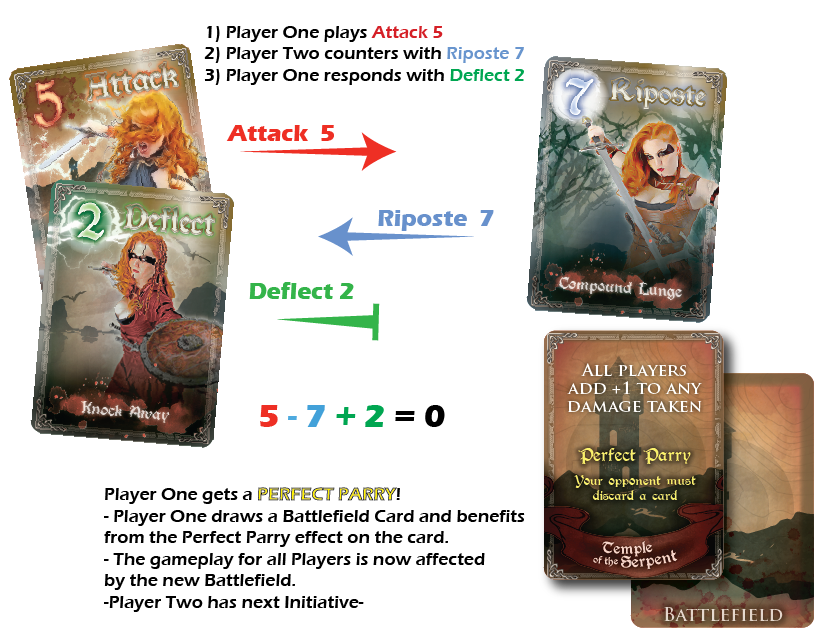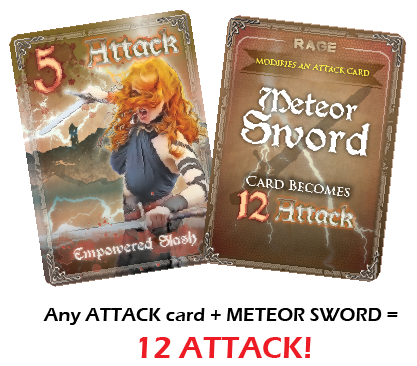ReaverQuest Gameplay
ReaverQuest is a fast card game of attacks and counterattacks that simulates the swordplay of two mighty warriors battling on the mystic landscape surrounding the Tower of Ravingspire!
Full 2-Player Game Tutorial Video
GAME SETUP
The ATTACK, RIPOSTE, DEFLECT and six (6) random RAGE cards are shuffled together.
Shuffle the BATTLEFIELD cards and place them next to the play area.
Each player chooses one of the three Hero cards to represent their Reaver and track damage.
Players begin each Round by being dealt six (6) cards from the Fight Deck by alternating players. The Player to the Dealer’s left has first Initiative.
Shuffle the BATTLEFIELD cards and place them next to the play area.
Each player chooses one of the three Hero cards to represent their Reaver and track damage.
Players begin each Round by being dealt six (6) cards from the Fight Deck by alternating players. The Player to the Dealer’s left has first Initiative.
BATTLES and ROUNDS
The Fight for dominance in ReaverQuest is played in a series of Rounds. Each Round consists of multiple Battles that are initiated by an Attack Card.
BATTLE: A Battle is the resolution of an exchange beginning with a single ATTACK card between two or three Reavers. The Battle can involve multiple RIPOSTES sending damage back and forth, but only one ATTACK card. The Battle ends when one Reaver takes damage or all damage is DEFLECTED away. A new Battle begins with each new ATTACK card played.
ROUND: A Round consists of multiple Battles exchanged between Reavers using a single Hand of cards. A Round ends when:
ROUND: A Round consists of multiple Battles exchanged between Reavers using a single Hand of cards. A Round ends when:
- Neither Player has an ATTACK card to play
- One Player takes FULL damage from an ATTACK card without defending in any way
- As the result of a specific RAGE card effect (e.g. Smoke Bomb)
ATTACK!
1) The Player with Initiative initiates a Battle with an ATTACK card.
2) The defender then may either DEFLECT to reduce or eliminate the damage, or a RIPOSTE card to reduce or return the remainder of the damage back at the attacker.
3) If the value of a RIPOSTE or DEFLECT card is less than the incoming damage of the Attack, then the defender suffers the remaining amount that was not prevented and reduces their Vigor accordingly.
4) If the value of a RIPOSTE Card is greater than the incoming damage, then the remaining damage transfers back toward the previous attacker, as if they had been Attacked! They may now respond with a DEFLECT or RIPOSTE card of their own.
5) Initiative for the next Battle always goes to the Player who didn't play the last card in the previous Battle, either offensively or defensively.
2) The defender then may either DEFLECT to reduce or eliminate the damage, or a RIPOSTE card to reduce or return the remainder of the damage back at the attacker.
3) If the value of a RIPOSTE or DEFLECT card is less than the incoming damage of the Attack, then the defender suffers the remaining amount that was not prevented and reduces their Vigor accordingly.
4) If the value of a RIPOSTE Card is greater than the incoming damage, then the remaining damage transfers back toward the previous attacker, as if they had been Attacked! They may now respond with a DEFLECT or RIPOSTE card of their own.
5) Initiative for the next Battle always goes to the Player who didn't play the last card in the previous Battle, either offensively or defensively.
Battle Example: A Simple Riposte
In the example above, Player 2 Riposted Player 1's Attack back at them (Attack 5 - Riposte 7 = -2 Damage), with 2 points going back at Player 1. Player 1 either cannot defend against the damage (because they don't have a Deflect or Riposte card) or they decided to take the damage and not defend back, so as to keep Initiative.
Battle Example: An Extended Melee
In this example, Player Two could only Deflect 4 of the 8 incoming damage, so the Battle ends and Player Two takes 4 damage. Furthermore, since Player Two played the last card in the Battle (Deflect 4), Player One gains Initiative for the next Battle.
A HERO'S VIGOR
Each battling Reaver can only take so much punishment before they must submit to their opponent. In ReaverQuest a Hero's remaining health and capability to continue the fight is known as their VIGOR.
When a Player takes damage they rotate their Hero card until their new Vigor level faces them upright. Once a Hero falls below 9 Vigor they flip over the card to the Wounded side to track the final 8 points of Vigor. When a Reaver loses all of their Vigor they are defeated. The last Reaver standing wins!
MYSTIC BATTLEFIELDS
The Tower of Ravingspire is a mercurial and magical font of ley power, located on a crossroads within the dimensional nexus. As such, the lands around the Tower have been known to slide between dimensions, suddenly altering the Battlefield for dueling Reavers!

If a defender plays a DEFLECT card that results in the sum of the current battle damage resulting in exactly zero (0), they have performed a PERFECT PARRY. The mystic Battlefield responds to their skill. They may draw a BATTLEFIELD card and place it next to the play area.
PERFECT PARRY
In the below example, after Player 2 Ripostes damage back, Player 1 plays a Deflect card of the exact damage value coming back at them to make the final result zero (0). This is known as a Perfect Parry, and Player 1 may draw a Battlefield card.
As Player 1 played the last card in the Battle, Player 2 has Initiative for the next Battle.
As Player 1 played the last card in the Battle, Player 2 has Initiative for the next Battle.
Battle Example: A Perfect Parry
Had Player 1 played a higher-value Deflect card than the damage coming back at them (e.g. Deflect 5 vs. damage 2) then the remaining Deflect value (+3) would have been lost (in a 2-Player game) or been transferred onto the inactive Player (in a 3-Player game).
RAGE!
Within the FIGHT deck are RAGE cards that boost the combat abilities of the battling Reavers.
|
